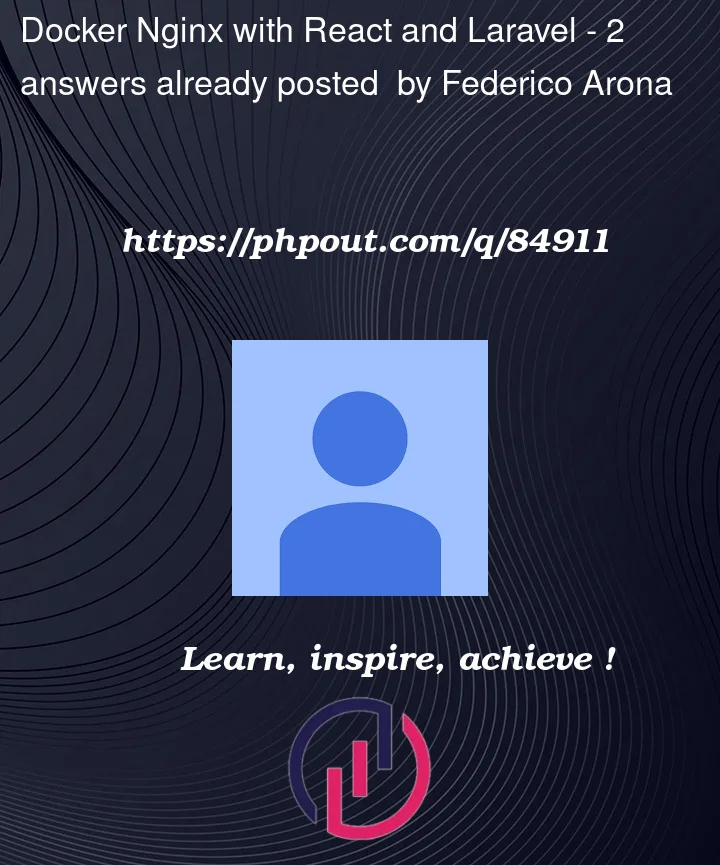So I want to have a single Nginx web server serving both frontend and backend with Docker.
Here is my docker-compose:
version: "3.8"
services:
db: #mysqldb
image: mysql:5.7
container_name: ${DB_SERVICE_NAME}
restart: unless-stopped
environment:
MYSQL_DATABASE: ${DB_DATABASE}
MYSQL_ROOT_PASSWORD: ${DB_PASSWORD}
MYSQL_PASSWORD: ${DB_PASSWORD}
MYSQL_USER: ${DB_USERNAME}
SERVICE_TAGS: dev
SERVICE_NAME: mysql
ports:
- $MYSQLDB_LOCAL_PORT:$MYSQLDB_DOCKER_PORT
volumes:
- ./docker-compose/mysql:/docker-entrypoint-initdb.d
networks:
- backend
mrmfrontend:
build:
context: ./mrmfrontend
args:
- REACT_APP_API_BASE_URL=$CLIENT_API_BASE_URL
- REACT_APP_BACKEND_ENDPOINT=$REACT_APP_BACKEND_ENDPOINT
- REACT_APP_FRONTEND_ENDPOINT=$REACT_APP_FRONTEND_ENDPOINT
- REACT_APP_FRONTEND_ENDPOINT_ERROR=$REACT_APP_FRONTEND_ENDPOINT_ERROR
- REACT_APP_CUSTOMER=$REACT_APP_CUSTOMER
- REACT_APP_NAME=$REACT_APP_NAME
- REACT_APP_OWNER=""
ports:
- $REACT_LOCAL_PORT:$REACT_DOCKER_PORT
networks:
- frontend
nginx:
image: nginx:alpine
container_name: backend-nginx
restart: unless-stopped
ports:
- 8000:80
volumes:
- ./MRMBackend:/var/www
- ./docker-compose/nginx/backend:/etc/nginx/conf.d/
networks:
- backend
- frontend
app:
build:
args:
user: admin
uid: 1000
context: ./MRMBackend
dockerfile: Dockerfile
image: backend
container_name: backend-app
restart: unless-stopped
working_dir: /var/www/
volumes:
- ./MRMBackend:/var/www
networks:
- backend
volumes:
db:
networks:
frontend:
driver: bridge
backend:
driver: bridge
And here’s the Dockerfile for the frontend:
FROM node:16.13.0 as build-stage
WORKDIR /app
COPY package.json ./
COPY package-lock.json ./
COPY ./ ./
RUN npm i
ARG REACT_APP_API_BASE_URL
ARG REACT_APP_BACKEND_ENDPOINT
ARG REACT_APP_FRONTEND_ENDPOINT
ARG REACT_APP_FRONTEND_ENDPOINT_ERROR
ARG REACT_APP_CUSTOMER
ARG REACT_APP_NAME
ENV REACT_APP_API_BASE_URL=$REACT_APP_API_BASE_URL
ENV REACT_APP_BACKEND_ENDPOINT=$REACT_APP_BACKEND_ENDPOINT
ENV REACT_APP_FRONTEND_ENDPOINT = $REACT_APP_FRONTEND_ENDPOINT
ENV REACT_APP_FRONTEND_ENDPOINT_ERROR = $REACT_APP_FRONTEND_ENDPOINT_ERROR
ENV REACT_APP_CUSTOMER=$REACT_APP_CUSTOMER
ENV REACT_APP_NAME=$REACT_APP_NAME
ENV GENERATE_SOURCEMAP=false
RUN npm run build
The problem is that the frontend container can’t seem to start. It exit always at startup.
From my understanding I should copy the build content of the build-stage into the nginx folder "/usr/share/nginx/html" but how can I do it from the docker-compose file?
Just using volumes won’t work. I need nginx in the docker-compose because it’s also serving the backend.
Please note that the backend is working correctly.
UPDATE
My first approach was to use a Dockerfile for the frontend where I copied the content of the build directly into an Nginx image
# Stage 1
FROM node:16.13.0 as build-stage
WORKDIR /app
COPY package.json ./
COPY package-lock.json ./
COPY ./ ./
RUN npm i
ARG REACT_APP_API_BASE_URL
ARG REACT_APP_BACKEND_ENDPOINT
ARG REACT_APP_FRONTEND_ENDPOINT
ARG REACT_APP_FRONTEND_ENDPOINT_ERROR
ARG REACT_APP_CUSTOMER
ARG REACT_APP_NAME
ENV REACT_APP_API_BASE_URL=$REACT_APP_API_BASE_URL
ENV REACT_APP_BACKEND_ENDPOINT=$REACT_APP_BACKEND_ENDPOINT
ENV REACT_APP_FRONTEND_ENDPOINT = $REACT_APP_FRONTEND_ENDPOINT
ENV REACT_APP_FRONTEND_ENDPOINT_ERROR = $REACT_APP_FRONTEND_ENDPOINT_ERROR
ENV REACT_APP_CUSTOMER=$REACT_APP_CUSTOMER
ENV REACT_APP_NAME=$REACT_APP_NAME
#avoid javascript out of memory
ENV GENERATE_SOURCEMAP=false
RUN npm run build
# Stage 2
FROM nginx:1.17.0-alpine
COPY --from=build-stage /app/build /usr/share/nginx/html
EXPOSE $REACT_DOCKER_PORT
CMD nginx -g 'daemon off;'
But in this way I think I’m deploying two Nginx. One in the Dockerfile and one in the Docker-compose. Am I right?




2
Answers
I mostly use Docker multi-build to configure my FE app. Hope this might help you!
you can use default nginx configuration.
@federico-arona
As stated in my comment: If you want to have 1 nginx you need to share or copy the files from the container that is building the app.
Based on your requirements and what you wanted to accomplish. The best solution is named volumes, as they can be shared across containers.
They are the preferred mechanism for persisting data generated by and used by Docker containers. Plus you can manage volumes using Docker CLI commands and the Docker API. The Official docs show other benefits and additional information on how to use them.